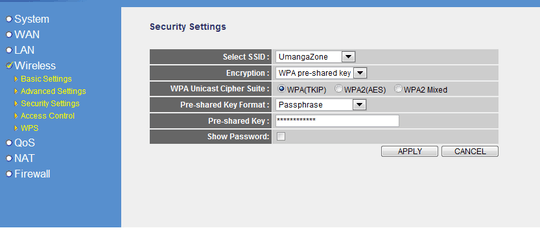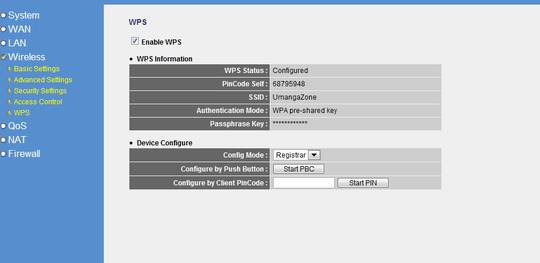Those 15-20 megabit/sec throughputs you're seeing are fine for 802.11g, which is what (unbeknownst to you) you're actually configured to use here.
The IEEE 802.11n spec requires that you do WPA2 (AES-CCMP) or no security, and it requires that you do QoS (WMM). You've blocked yourself from doing 802.11n by doing TKIP-only and disabling WMM.
Also, by setting your channel width the 20MHz only, you've limited your N data rates to 144.4 mbps max. (Don't get me wrong, using 20MHz-wide channels is the right thing to do from a "good neighbor" perspective in the crowded 2.4GHz band. If you wanted to use Bluetooth on a client machine that was also doing 40MHz-wide 802.11n in the 2.4GHz band, it might not work out very well.)
Also note that the rule of thumb for Wi-Fi TCP throughput—on an app that uses TCP in an optimal manner—is 50-60% of the signaling rate. So even if you made the 3 changes I suggested above, and you truly had a good 300mbps N client machine (2 spacial streams in both directions, support for 40MHz channels in 2.4GHz) within good range of the AP, you shouldn't expect to see performance much greater than 150 megabits/sec (about 18 MebiBytes/sec).
By the way, please tell me that these settings (TKIP only, WMM off, 20MHz-only) were not the factory defaults for this product. That would be really sad if they didn't know better and were accidentally effectively disabling their marquee feature by default.




It might help to tell folks what kind of wireless router we're talking about here... – voretaq7 – 2012-04-27T05:54:58.127
2Think this belongs superuser or systemfault. Not here – kingchris – 2012-04-27T05:14:09.650
The main point is that the 300 Mb/s is the maximum signalling rate of the interface in case you can use two channels and there isn't any interference from outside sources. There is also considerable overhead due to the way the WiFi itself works. A considerable percentage of data being transmitted isn't the actual data you're sending. Instead it's data related to the maintenance of the connection itself. In wired Ethernet, that overhead is somewhat lower. – AndrejaKo – 2012-04-27T05:43:57.007
1
TKIP and 802.11n are incompatible on most hardware. Use WPA2-AES. Many devices drop to 54Mbps if you use TKIP.
– David Schwartz – 2012-04-27T07:03:51.3172umanga, in the future, please never post the same question across multiple sites. This most likely leads to a mess like here. – slhck – 2012-04-27T07:08:28.753
@slhck sorry for that.I was only using StackOverflow before and confused to post in the correct site. – Ashika Umanga Umagiliya – 2012-04-27T07:12:01.357
@DavidSchwartz I cannot find your answer to give a vote up! – Ashika Umanga Umagiliya – 2012-04-27T07:13:36.443
@umanga it looks like David self-deleted his answer. Not sure why. – nhinkle – 2012-04-27T07:17:59.803
1Also @umanga I merged your migrated post into this one. If you ever ask a question on the wrong site by accident in the future, don't worry about reposting it - things tend to get migrated pretty quickly. – nhinkle – 2012-04-27T07:19:42.733
@umanga: He indicated he was measuring using a site that does report speeds in Mbps, not MB/s. So I think his issue is actually TKIP not compatible with 802.11n, or his end device not supporting 802.11n. (Or possibly, extremely poor signal, high interference, or the like.) – David Schwartz – 2012-04-27T11:38:44.547